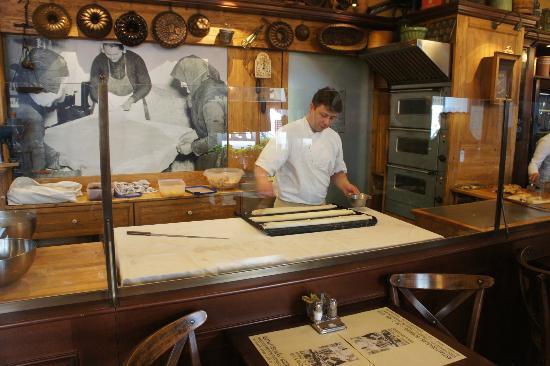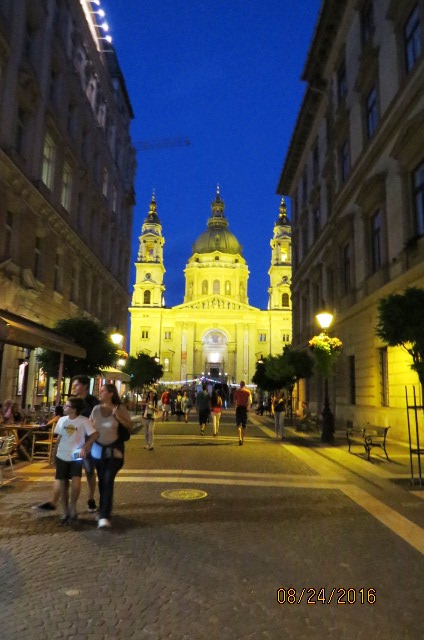Our guided tour had ended and, before taking her leave, Barbara arranged to meet us at the hotel to take us to the included dinner. We five wandered a short distance from the square and found a spot to have a bite to eat. I seem to recall that there was some confusion over the checks, that our server and the manager claimed the credit card connection was broken, and insisted we pay in cash causing the five of us to scramble about because not everyone had enough cash on hand. Then, using our group ticket, we boarded a bus that became quite crowded on its way to Vörösmarty Square where we hopped off and walked to the pier to buy tickets for a dinner cruise along the river the following night. With that transaction complete, we split into our now customary tribes of two and three.
You want it. We’ve got it.
Pat and I decided to walk along Dunakorzó toward Szabadság hid and visit Nagyvásárcsarnok. Okay, in English: We decided to walk along the Danube Promenade toward Liberty Bridge and visit the Great Market Hall (sometimes called the Central Market) but I’ve come to like writing these long agglutinative Hungarian words. So, sue me.
Another outgrowth of the 1896 millennial festivities, the Great Market Hall is both the oldest and, at 10,000 square meters, the largest indoor market in Budapest. Situated on Pest’s side of the river, it faces Fővám Square at one end of Váci Street and connects to Buda via the Liberty Bridge. Although much is made of the Chain Bridge because it’s the oldest span connecting the cities of Buda and Pest, for me, the Liberty Bridge completed in (you guessed it!) 1896, is aesthetically more interesting.
Technically, it’s a cantilever truss bridge with a suspended middle span but it’s built to stylistically imitate a chain bridge. Originally named for Emperor Franz Joseph who is said to have driven in the last rivet on the Pest abutment, it connects Fővám Square in Pest with Gellert Square in Buda.
Although from this angle and distance the bird on top of the mast looks like an eagle, it’s actually a Turul – a mythical bird of prey adopted in the ninth or tenth century as a clan symbol by the ruling House of Árpád. From then on, the Turul flew into Hungarian consciousness becoming a divine messenger that’s often depicted carrying the flaming Sword of God. The website HunMagyar describes part of the legend:
A Hungarian legend tells the story of Emese, wife of Ügyek the descendant of Atilla, who once had a dream in which a Turul appeared to her. In this dream, a crystal-clear stream started to flow from her, and as it moved Westward, it grew into a mighty river. This dream represented her symbolic impregnation by the Turul, and meant that she would give birth to a line of great rulers. Emese later gave birth to Álmos, who was the father of Árpád, the great leader of the Magyars and founder of Hungary. This story reaffirms the Hun-Magyar kinship, and the knowledge that the Magyars reconquered Hungary as their rightful inheritance from Atilla’s great Hun Empire.
The video below is only about a minute and a half long, has some lovely views, and I think the event is cool.
The exterior of the Great Market has, in my view, two notable features. First, the main entrance which, despite its relative modernity (the building is only 120 years old, after all), has a distinct neo-Gothic look. Second, the colorful tiling that adorns the roof clearly evokes that of Matthias’ Church.
The market is spread over three floors though we only browsed on two of them. The ground floor is crowded with stalls selling fresh produce, prepared and pre-cut meat, spices, candy, liquor, and the like. The second floor has small informal eateries – sort of Hungarian fast food – and both craft and souvenir shops. Pat and I didn’t get to the basement where we would have found fish mongers, butchers, and pickle shops that, I’ve read, will pickle any sort of plant food.
Here’s a five-minute tour:.
Sadly, my favorite souvenir, a bottle opener attached to a wooden phallus (because everyone needs a penis shaped bottle opener), doesn’t appear in it.
After our market excursion, we returned to the hotel to rest and freshen up before dinner. We met Barbara in the hotel lobby and set off for Első Pesti Rétesház Kávéház or the First Strudel House of Pest. Along the way, we got a lesson in both goulash and strudel.
So you think you know goulash.
Given its down to earth components, you’d be right on target if you assumed that goulash is, at heart, peasant food. The origin of the word is gulyás – essentially the Hungarian term for cowboy. (Specifically, the term describes mounted cattle-herdsmen which sounds like a cowboy to me.) Years ago, the dish was known by the longer term gulyáshús (goulash meat) to differentiate between the herdsmen and the stew but this is no longer the case. Because they were on the plains for days at a time, the gulyás prepared their meals in a large bogrács (cauldron) using provisions they carried with them.
In fact, they originally called this meal bográcsgulyás and it described a stew rather than a soup. A traditional bográcsgulyás is still cooked outdoors in a cauldron over an open fire. As the dish became urbanized, it became more a soup than a stew and it’s the former that you’re most likely to encounter in Hungarian restaurants. For many locals, however, gulyás remains a stew and they call the soupier restaurant style gulyásleves (leves is Hungarian for soup).
A typical gulyásleves starts with a meat-based broth and contains chunks of meat – usually beef but also pork, mutton or lamb. Potatoes are used to add some thickness and the recipe also uses other root vegetables such as carrots. The soup is seasoned with garlic and caraway seed but the main spice is the one for which Hungary is best known – paprika. If you ever eat a goulash with tomatoes, you’re eating a relatively modern adaptation because the tomato didn’t become a part of central European food culture until sometime in the 20th century. Everyone but me opened the meal with a bowl of goulash. I demurred because of the meat.
Strudel – it’s not just for dessert.
While you will certainly find sweet strudel in Hungary, you’re also likely to encounter savory strudel. Strudel in Hungary is more properly called rétes. Sweet rétes will typically have some sort of fruit (apple, cherry, plum, apricot, or raisin) or cheese (cottage or quark) while savory rétes might have cabbage, pumpkin, spinach, or even sauerkraut. There are meat rétes, too. This is one of the two plates we had:.
As you can see, this plate has both sweet and savory rétes.
The restaurant is on Oktober 6 Street. (On 6 October 1849, thirteen Hungarian generals and Hungary’s first prime minister Count Lajos Batthyány were executed by order of Emperor Franz Joseph.) I immediately noticed the wonderful aromas of baking and spices greeting us as we entered. The first thing you see is where and how they make the strudel.
Traditional Hungarian strudel pastry dough is highly elastic. It’s made from high gluten flour, water, oil, and salt. The baker works the dough quite vigorously and allows it to rest before rolling it out and stretching it by hand until it’s very, very thin. It’s said that, done properly, the dough should be so thin that you can read a newspaper through it.
The restaurant’s interior design is a combination of early 20th century classicism with hints of baroque and art nouveau in its three main areas. To the baker’s right in the photo above is the main dining room. It’s an elegant space with arched ceilings and tables lit by candlelight and adorned with fresh flowers. Adjoining the formal dining area there’s the more casual space you see a bit of above. It has the ambience of a café. Beyond that is a rustic and traditional dining area with long wooden tables intended to provide an authentic communal feel. This is
where our group sat and enjoyed our gulyásleves and rétes.
After dinner on our way back to the hotel, we stopped to take photos of the old time Hungarian policeman who stands watch at the intersection of Oktober 6 and Zrinyi streets. Pat snapped this one of Jackie and Connie.
(I think he looks like Sergeant Schultz from Hogan’s Heroes.)
Equally interesting is the view the three of them had looking up Zrinyi Street
at Saint Stephen’s Square and Basilica.
We’ve reached the end of a long day. Tomorrow, Jackie, Connie, and Geanie will take a tour to Szentendre while Pat and I stay behind and explore Pest a bit more. We’ll then gather as a group for that dinner cruise along the Danube. So, stay tuned. There’s more Budapest – okay, more Pest – to come.





